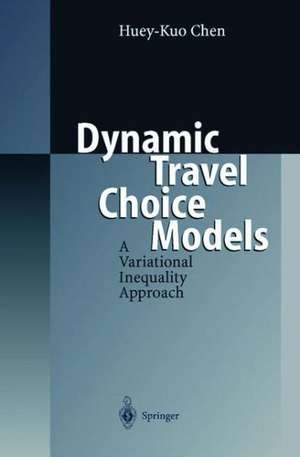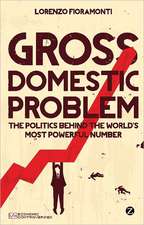Dynamic Travel Choice Models: A Variational Inequality Approach
D. Boyce Autor Huey-Kuo Chenen Limba Engleză Paperback – 18 noi 2011
Preț: 390.84 lei
Nou
Puncte Express: 586
Preț estimativ în valută:
74.79€ • 78.28$ • 62.25£
74.79€ • 78.28$ • 62.25£
Carte tipărită la comandă
Livrare economică 31 martie-14 aprilie
Preluare comenzi: 021 569.72.76
Specificații
ISBN-13: 9783642642074
ISBN-10: 3642642071
Pagini: 344
Ilustrații: XVII, 320 p.
Dimensiuni: 155 x 235 x 18 mm
Greutate: 0.48 kg
Ediția:Softcover reprint of the original 1st ed. 1999
Editura: Springer Berlin, Heidelberg
Colecția Springer
Locul publicării:Berlin, Heidelberg, Germany
ISBN-10: 3642642071
Pagini: 344
Ilustrații: XVII, 320 p.
Dimensiuni: 155 x 235 x 18 mm
Greutate: 0.48 kg
Ediția:Softcover reprint of the original 1st ed. 1999
Editura: Springer Berlin, Heidelberg
Colecția Springer
Locul publicării:Berlin, Heidelberg, Germany
Public țintă
ResearchCuprins
1 Analysis of Dynamic Transportation Systems.- 1.1 Introduction.- 1.2 Significance of Dynamic Transportation Network Models.- 1.3 Traffic Information and Transportation Network Models.- 1.4 Equilibrium over Transportation Networks.- 1.5 Dynamic Equilibrium Conditions.- 1.6 Scope and Organization of the Book.- 1.7 Notes.- 2 Mathematical Background.- 2.1 Variational Inequality Problem and Some Related Mathematical Problems.- 2.2 Existence and Uniqueness.- 2.3 Solution Algorithms.- 2.4 Notes.- 3 Network Flow Constraints and Link Travel Time Function Analysis.- 3.1 Flow Conservation Constraint.- 3.2 Flow Propagation Constraints.- 3.3 Nonnegativity Constraints.- 3.4 Definitional Constraints.- 3.5 First-In-First-Out Constraints.- 3.6 Link Capacity and Oversaturation.- 3.7 Link Travel Time Function Analysis.- 3.8 Notes.- 4 Dynamic User-Optimal Route Choice Model.- 4.1 Equilibrium Conditions and Model Formulation.- 4.2 Numerical Example.- 4.3 Static Counterpart Approximation.- 4.4 Multiple Optima.- 4.5 Notes.- 5 Algorithms for the Dynamic Route Choice Model.- 5.1 Link Interactions.- 5.2 Nested Diagonalization Method.- 5.3 Nested Projection Method.- 5.4 Modified Nested Projection Method.- 5.5 Numerical Example.- 5.6 Notes.- 6 Dynamic User-Optimal Departure Time/Route Choice Model.- 6.1 Equilibrium Conditions and Model Formulation.- 6.2 Nested Diagonalization Method.- 6.3 Numerical Examples.- 6.4 Analysis Period and Total Number of Time Intervals.- 6.5 Notes.- 7 Dynamic User-Optimal Models with Variable Demand.- 7.1 Dynamic User-Optimal Variable Demand/Route Choice Mode.- 7.2 Dynamic User-Optimal Variable Demand/Departure Time/Route Choice Model.- 7.3 Notes.- 8 Dynamic User-Optimal Mode Choice Models.- 8.1 Dynamic User-Optimal Mode Choice/Route Choice Model.- 8.2 Dynamic User-Optimal Mode Choice/Departure Time/Route Choice Model.- 8.3 Notes.- 9 Dynamic User-Optimal Singly Constrained O-D Choice Models.- 9.1 Dynamic User-Optimal Singly Constrained O-D Choice/Route Choice Model.- 9.2 Dynamic User-Optimal Singly Constrained O-D Choice/Departure Time/Route Choice Model.- 9.3 Notes.- 10 Dynamic System-Optimal Route Choice Model.- 10.1 Marginal Link Travel Time Function Analysis.- 10.2 Equilibrium Conditions and Model Formulation.- 10.3Nested Diagonalization Method.- 10.4 Numerical Example.- 10.5 Comparison of Network Travel Times for the DSO and DUO Route Choice Problems.- 10.6 Static Counterpart Approximation.- 10.7 Braess’s Paradox.- 10.8 Toll Policies.- 10.9 Notes.- 11 Dynamic Signal Control Systems.- 11.1 Dynamic Network Signal Control System.- 11.2 Dynamic Traffic-Responsive Signal Control System.- 11.3 Notes.- 12 Stochastic/Dynamic User-Optimal Route Choice Model.- 12.1 Stochastic/Dynamic Route Travel Time Function Analysis.- 12.2 Equilibrium Conditions and Model Formulation.- 12.3 Nested Diagonalization Method.- 12.4 Numerical Example.- 12.5 Deterministic Counterpart Approximation.- 12.6 Braess’s Paradox.- 12.7 Notes.- 13 Fuzzy/Dynamic User-Optimal Route Choice Model.- 13.1 Fuzzy/Dynamic Link Travel Time Function Analysis.- 13.2 Equilibrium Conditions and Model Formulation.- 13.3 Nested Diagonalization Method.- 13.4 Numerical Example.- 13.5 Fuzzy/Static Counterpart Approximation.- 13.6 Notes.- 14 Future Research and Applications.- 14.1 Research Directions.- 14.2 Applications.- 14.3 Notes.- References.- List of Figures.- List of Tables.- Author Index.- Summary of Notation.
Caracteristici
Better understanding of the transportation planning process In-depth skills of mathematical programming















